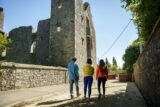Notice
Athlumney Castle is a National Monument in state guardianship
WARNING: It should be noted that these sites are unguided and a level of care and caution should be maintained during all stages of your visit. The Office Of Public Works (OPW) will not be held responsible for any damages, injuries, or losses that occur
Athlumney Castle
The elegant remains of this 15th century tower house and its attached 16th or early 17th century manor house sit at the intersection of Navan’s Convent Road and Elm Park, within a quiet residential housing estate high on the eastern bank of the River Boyne. The name Athlumney derives from the Irish for “Loman's ford”, and is believed to be the place where St. Loman, the first Bishop of Trim in Co. Meath, and traditionally reputed to be a nephew of St. Patrick, crossed the river.
Overlooking a key strategic point where the Leinster Blackwater river drains into the Boyne river, the site is accessed through a small gate on Convent Road, through a tall wall that encloses a large garden, most of which is owned by the Sisters of Mercy religious order.
Athlumney Castle lies on a north-east/south-west axis, and consists of the older tower house, which was subsequently added to, on its south-west facing wall, with the fortified four-bay Tudor manor house. In 1775, the artist Gabriel Berenger drew the castle, showing that a two-storey addition to the tower house also existed, projecting from its north-east facing wall.
The four-storey tower house was built by the powerful and influential Catholic Dowdall family of Co. Louth. In 1446, Robert Dowdall of Newtown Termonfeckin, was appointed Chief Justice of the Common Pleas in Ireland, his son Thomas was Master of the Rolls in 1488, and James Dowdall was appointed Chief Justice of the Queen’s Bench in 1583.
The tower house has an internal spiral staircase, and holes for floor beams can still be seen on the first floor level. On its corners are projecting square turrets of varying sizes. The ground floor roof is barrel-vaulted and a murder hole protected the original entrance. On the first floor, in the south wall, a stairs of eleven steps from above leads to a secret mural chamber, which is assumed to be a priest’s hole, for hiding members of the Catholic clergy. Although the upper floors of the tower are missing, the staircase still leads up to the battlements.
The fortified four-bay Tudor manor house is three storeys high, with eight sets of square six-paned stone-mullioned windows, four on the first floor and four directly above these on the second floor. It is reminiscent of the Tudor-period design of Ormond Castle in Carrick-on-Suir in Co. Tipperary. Internally there were large corridors and the four huge fireplaces and the two ovens of its ground floor kitchen provided heat for the first floor where the family lived. The remains of elegant fireplaces on this upper floor are still to be seen.
The manor’s very modest entrance doorway, which appears to have been reduced in size at some point in time, is carved from limestone and a stone-mullioned oriel or bay window looks out to the south-west in the direction of the Boyne river. An inspection of the outer ground floor and garden walls shows several bricked-up entrances, which might have been closed for defensive or security purposes, or could suggest that there were other structures that now no longer exist.
During Oliver Cromwell's 1649 siege of Drogheda, the Maguire (Mac Uidhir) family, who were living at Athlumney, burned the house and tower to prevent them from falling into Cromwell’s hands. Four decades later, after James II’s defeat in July 1690 at the Battle of the Boyne, the castle’s owner, Sir Launcelot Dowdall, the last of this family to hold the title of Lord Athlumney, in order to deprive King William and his troops of a place to garrison, burned the castle down again before fleeing permanently to France. All of his Irish estates were confiscated in 1700.
The property later belonged to Sir William Somerville, Bart., Chief Secretary of State in Ireland from 1847 to 1852. He revived the title of Lord Athlumney in 1863. Following the later break-up of the Somerville family’s estate, the land around the castle was bought by Bishop Nulty for the Sisters of Mercy. The Order still owns a portion of the enclosed garden.
Visit Historic Environment Viewer for more information on Athlumney Castle
Protect our Past - Click here to read about the importance of protecting our country’s unique heritage sites
This national monument is protected in accordance with the National Monuments Acts 1930 to 2014
Gallery
Nearby sites to visit
Hill of Tara
Experience the legacy of the high kings
Approx. 9.0 km from Athlumney Castle
Trim Castle
The ultimate symbol of Norman glory
Approx. 13.1 km from Athlumney Castle
Brú na Bóinne Visitor Centre: Newgrange, Knowth and Dowth
Step into Ireland’s richest archaeological landscape
Approx. 15.6 km from Athlumney Castle
Old Mellifont Cistercian Abbey Monastic Site
Visit Ireland’s very first Cistercian foundation
Approx. 17.2 km from Athlumney Castle
Battle of the Boyne Visitor Centre – Oldbridge Estate
Where two kings fought for Europe’s future
Approx. 18.7 km from Athlumney Castle
Maynooth Castle
A glimpse of life in a Norman fortress
Approx. 30.4 km from Athlumney Castle


